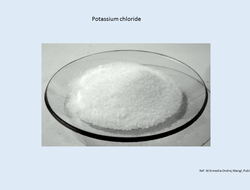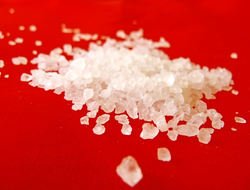Chloride: an important mineral and electrolyte
Published: July 13, 2018
Chloride (Cl-) forms when chlorine (Cl2) reacts with hydrogen or sodium.
Whereas chlorine is a poisonous gas, chloride is an essential mineral and the most abundant anion in your extracellular fluid: fluids such as blood which bathe cellular tissue.
The total amount of chloride within your body represents about 0.15% of your body weight which is about 105 g for a 70 kg person.
Approximately 12% of this amount is found within your cells, but the bulk of chloride (88%) is within you extracellular fluid.
Anions such as Cl- have a negative charge and are commonly associated with positively charged cations such as sodium (Na+) and potassium (K+).
The amount of chloride within your body is about the same as the amount of sodium with which it is commonly associated.
Functions
Chloride has several important functions in your body:
Electrolyte balance
Chloride is one of several electrolytes in your body and with sodium and potassium is necessary for maintaining your body’s homeostasis.
As an electrolyte, chloride assists with fluid balance, delivery of oxygen to your cells, and acid-base balance.
In your extracellular fluid, chloride which can move easily across cell membranes associates with sodium, but within your cells associates with potassium. Together, electrolytes maintain a voltage across cell membranes which functions to carry other nutrients in and out of cells.
Electrolytes are particularly important in muscle, nerve, and heart cells where they act together to conduct electrical impulses for nerve impulses and muscle contractions.
Your kidneys maintain consistent blood electrolyte concentrations.
The term “electrolytes” refers to salts, such as sodium chloride and potassium chloride which dissolve in water and separate into charged ions: Sodium = Na+, Chloride = Cl-, and Potassium = K+.
Water containing dissolved electrolytes can conduct an electrical current and is known as an electrolyte solution.
The negative and positive charges are matched so that if more negative ions come into the solution negative ions must leave or positive ions must enter the solution to equalise the negative ions.
That is, if Na+ ions come into the solution K+ ions must leave. Sodium and potassium usually move in opposite directions across cell membranes.
Sodium and chloride are generally found outside of body cells while potassium, magnesium, sulfate and phosphorus are found within cells.
Water is attracted to electrolytes and will follow electrolytes in and out of cells moving towards the highest solute concentration by a process known...link to the full article to learn more.
References
1.
.Gropper, S.S., Smith, J.L. & Groff, J.L. (2005). Advanced Nutrition and Human Metabolism (4thEd.). Belmont, CA: Thomson Wadsworth.
2.
Whitney, E. & Rady Rolfes, S. (2005). Understanding Nutrition. Belmont, CA: Thomson Wadsworth


